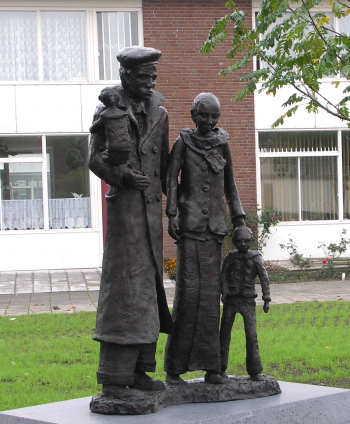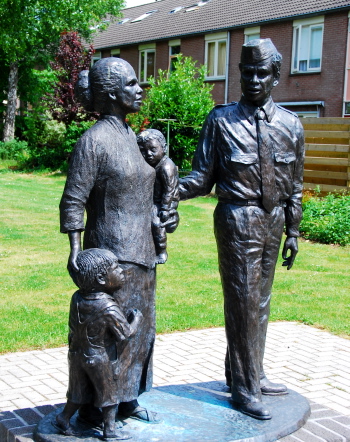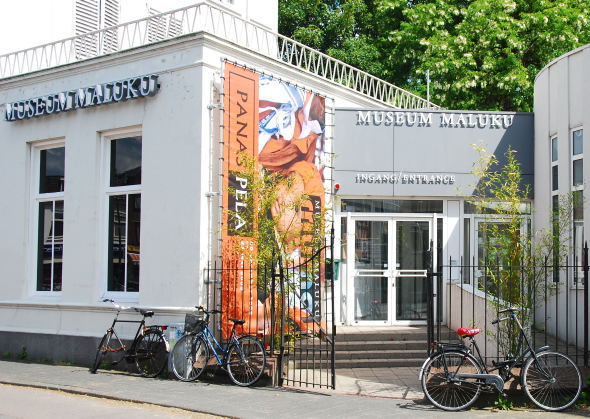Monuments help Dutch Moluccans to make the Netherlands home
Fridus Steijlen
 |
The monument in Moordrecht is a Moluccan project to remember thehardship of the first generationFridus Steijlen |
Two Moluccans in their fifties stand on a road looking over a snow-covered field. They had lived there in a camp until 1962. They discuss the site with a local farmer, showing him pictures. All three are making gestures as if trying to draw the contours of a former camp in the air. The visitors experience a feeling of nostalgia looking at their former playground. But that feeling is ambivalent. Their return to the camp site also reminds them of the hard times their parents went through when they were forced to come to the Netherlands. They now plan to lobby for a monument to preserve their history, concerned that otherwise their 'past will be covered with snow forever'.
Having left other kinds of landmarks like churches on the Dutch landscape, Moluccans are now erecting monuments in remembrance of their arrival in the Netherlands and to pay homage to the 'first generation'. It is an intriguing development because for a long time Moluccans and Dutch alike were convinced they would return to Indonesia; that their future was there and not in the Netherlands. But now their monuments are becoming an integral part of the Dutch remembrance landscape because the Moluccans are here to stay.
From camps to wards
The majority of Moluccans came to the Netherlands in 1951 as part of a group of former soldiers in the Dutch colonial army. Their support for the separatist South Moluccan Republic (RMS) in 1950 and the political turmoil that followed had made their position in Indonesia untenable. Most considered themselves citizens of the RMS. They set up their own RMS movement supporting the RMS guerrillas on the island of Ceram.
Forced by the circumstance, some 3500 Moluccan soldiers and their families – a total of 12,500 people – were transferred to the Netherlands. Moluccans as well as the Dutch government were convinced that the exiles would return in a couple of months. In the meantime, they were housed in provisional camps socially and physically isolated from Dutch society.
Some 90 camps were established before the Dutch government started to build special Moluccan wards in small towns in the 1960s. The transfer from camps to wards took more than 18 years. Sometimes police force was required to facilitate resettlement because some Moluccans considered the transfer to more permanent housing as a denial of the Dutch government's promise for an eventual return to an independent Moluccas. Until that day had come, they felt the Dutch government had an obligation to fully support them.
After the camps were emptied, most were dismantled or given other functions. Some were transformed into holiday resorts while others were taken over by farmers or were pulled down to make place for houses. Others still were simply torn down, leaving isolated markers like the ruin of a central kitchen. Just one camp in Vught, called Lunetten, survived as a living quarter for Moluccans, after it was renovated following long negotiations and conflicts between the inhabitants and the Dutch government.
The wards where the Moluccans came to be housed can be very small, just a few houses in one or two streets. In most, the housing corporation permits a Moluccan council to decide who is allowed to live there. The wards remained the main space for Moluccan communities until the end of the 1970s, when more and more Moluccans moved elsewhere because of study or work and a lack of housing. Although more than 60 per cent of Dutch Moluccans now live outside the Moluccan wards, many are still emotionally attached to them. They symbolise their exile and migrant history and a sense of close-knit community.
 |
The Dutch-initiated monument in Vaassen intends to leave the pastbehindFridus Steijlen |
Partly due to this sense of separate community, the RMS movement remained very strong in the Netherlands and continued to dominate the Dutch Moluccan identity until the end of the 1970s. The movement radicalised with the participation of second generation Dutch Moluccans. In the mid 1970s armed groups of young Moluccans staged a series of hijacks to add force to their case, occupying trains, a school and a government building in the north of the Netherlands and the Indonesian consulate in Amsterdam. In total eight hostages and six hijackers were killed.
Yet others in the same second generation of Dutch Moluccans initiated heated discussions within the Moluccan community on the meaning and continued relevance of the RMS ideology. Moluccans started to redefine their position in the Netherlands and their relationship to their homeland. Until then, they had considered themselves as exiles with a future in the Moluccas. Now, they became migrants, still connected with the Moluccas through family and village networks, but with a future in the Netherlands.
Nevertheless, RMS symbols have remained important as identity markers. Even today, Moluccan wards can be recognised by graffiti and other signs of 'Moluccan-ness', like little RMS flags in a windowsill or on bumper stickers. But these signs are mainly used to distinguish themselves from other migrants, indicating their unique position in the Netherlands owing to their role in Dutch colonial history.
New clashes broke out between Moluccans and Dutch authorities over neglect of their social economic position and the 'old rights' of the former KNIL soldiers, who had been unexpectedly discharged from the army upon arrival in the Netherlands. The Dutch government and the largest Moluccan organisation reached an agreement in 1986, which led to an effort to pay tribute to the first generation of Moluccans, the former colonial soldiers. A special policy was also adopted to improve the social economic position of the Moluccan community. Part of the pact was a fund to renovate Moluccan churches. This resulted in a wave of new Moluccan churches in the Moluccan wards, creating another set of landmarks.
Museums and monuments
Another part of the 1986 agreement was to create a 'living monument'. This came in 1990 as the Moluccan Museum in Utrecht. There had been discussions about erecting a statue but the Indonesian embassy had objected because they feared that it would function as rallying point for demonstrations against Indonesia.
Besides a documentation centre and theatre, the museum hosts a permanent exhibition about the history of Moluccans in the Netherlands. One room is dedicated to the nature and culture of the Moluccas, three other rooms emphasise the decolonisation, the proclamation of the RMS and transfer to the Netherlands and the integration process in the Netherlands. The exhibition tries to avoid political sensitivities but clearly tells the story from the Moluccan perspective. One of the most impressive parts of the museum consists of a corridor with old cabin trunks where the Moluccans lived on the boats to the Netherlands and a replica of a room in one of the barracks.
More recently, a series of monuments have been built. The first, erected in 1997, was a boulder to commemorate the former location of a camp for the minority of Islamic Moluccans in Balk in the North of the Netherlands, closed in 1969. Seven cloves and a nutmeg on the boulder refer to the motive for the Dutch to start their colonial adventure around 1600. Other monuments put the emphasis less on the colonial theme than on the Moluccan experience in the Netherlands. But different perspectives have resulted in very different monuments.
An interesting illustration is the creation of two monuments that were unveiled in September and October 2006 in the Moluccan wards of Moordrecht and Vaassen, some 100 kilometres apart. Both represent a Moluccan family: father, mother and two children. The Moordrecht sculpture shows the family in winter dress, representing the arrival of the Moluccans at the bitter cold Dutch harbours in 1951. Their posture and faces show the hardship they had faced and their fears about life in the Netherlands. The sculpture in Vaassen presents an entirely different vision. The mother is again in traditional dress but the father wears a summer uniform. With his right hand he guides his wife to the future, to which he points with his other hand. The Vaassen family is clearly more prosperous.
 |
Museum Maluku in Utrecht tells the story from the Moluccan perspectiveFridus Steijlen |
The difference between the two monuments reflects the different backgrounds and different goals of their creators. The statue in Vaassen was designed by a Dutch sculptor and is an initiative from the local Dutch authorities. In 2001 tensions between Moluccans and Dutch – which were partly related to a violent dismantling of the local Moluccan camp in the 1970s – were still very much alive. One of the initiatives to improve the relations was to create a statue to help them to put their memories of their arrival and their often violent clashes with Dutch authorities behind them, and to help them give their identity meaning. By contrast, the Moordrecht monument was a purely Moluccan project financed by community donations, designed by a Moluccan on behalf of a group of second generation Moluccans who wished to honour their parents, who came to the Netherlands as pioneers and experienced great hardship. The sculpture is accompanied by a large canvas showing photographs of all first generation Moluccans who came to live in Moordrecht, which was attached to a blind wall overlooking the square in which the monument sits.
Tensions and tokens
In recent years more and more efforts have been made to establish reminders of the Moluccan history in the Netherlands. Sometimes tokens of that history are simply added to existing memorials, for example, to a camp's former function as a prison for Nazis. In some cases they commemorate traumatic experiences. In 2011 a monument will be erected on the dike where the camp of West Kapelle was located. This camp was the site of a clash between Moluccans and Dutch police in 1956, which had erupted over government policies considered to be against Moluccan interests. When the protests escalated, police surrounded the camp, arms were fired and the protesters were imprisoned. For many Moluccans memories of this clash are still highly emotional. The choice of the location for the West Kapelle monument can be interpreted as an attempt at reconciliation. But because the erection of the monument is planned to coincide with celebrations of the 60th anniversary of the arrival of Moluccans in the Netherlands, the monument is partly depoliticised and supported by Moluccans and Dutch alike.
Moluccans themselves also now attempt to use monuments for reconciliation, not only with the Dutch but with other ethnic minorities as well. Last January a Moluccan spokesperson suggested that a monument be erected in the city of Culemborg to celebrate the 50th anniversary of Moluccan presence in Culemborg in 2014 with multicultural festivities. This suggestion followed severe clashes that had taken place in this city between Moluccans and Moroccans. The incident had shown how the social structures of the Moluccan ward had broken down and that Moluccans are integrated into Dutch society. The Moluccan spokesperson called for better communication among the two communities in order to improve relations as well as for more attention to their common social and economic difficulties. These were significant remarks. To suggest a combination of a monument for the Moluccan presence and a multicultural festival is like putting the Moluccans at the forefront of the Dutch multicultural society, signalling that Moluccans have turned from exiles to migrants and have started to integrate into Dutch society.
Fridus Steijlen (steijlen@kitlv.nl) is researcher at the Royal Netherlands Institute of Southeast Asian and Caribbean Studies (KITLV) in Leiden. One of his specialisations is postcolonial migration. He has written several books on Moluccans in the Netherlands.

Tidak ada komentar:
Posting Komentar